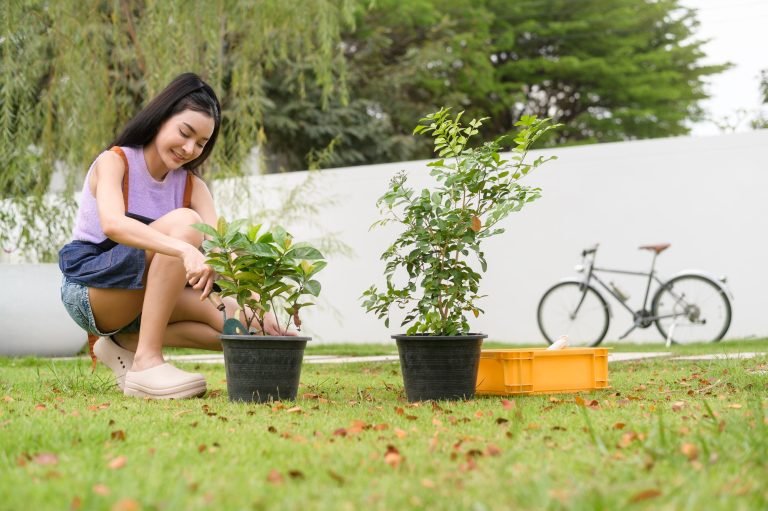There’s nothing worse than returning from a trip to find your once-thriving garden dried out, overgrown, or half-devoured by pests. A few days away is all it takes for nature to take a different turn if there’s no plan in place. But the good news? With a few simple steps, you can set up your garden to look just as healthy when you get home as it did the day you left.
Here’s how to keep things green, blooming, and under control even while you’re off the grid or soaking up the sun somewhere else.
Get the Lawn in Check Before You Go
One of the quickest things to spiral out of control is the lawn. Tall grass doesn’t just look messy, it also attracts pests and can smother the soil underneath.
Mow right before you leave with a sharp, well-maintained mower. This isn’t just about neatness. Cutting the grass to the ideal height helps reduce water needs while keeping the lawn healthy. Just don’t cut it too short, or it can dry out faster.
Skip the clippings if you’re headed out for more than a few days. Bag them instead of leaving them as mulch. This keeps moisture levels consistent without risking mold or suffocation in your absence.
If you’ll be gone for more than 10 days, and you don’t have someone to mow while you’re away, it’s worth trimming a little shorter than usual, but not scalping it. A mid-height cut gives you some leeway.
Deep Watering Is Better Than Daily Sprinkling
A light spray every day might seem helpful, but it actually trains your plants to stay shallow. If you’re going to be gone for a while, your garden needs roots that dig deep.
Give the whole garden a deep soak the day before you leave. That includes garden beds, pots, and shrubs. Focus especially on anything newly planted, since young roots are still fragile.
Water in the early morning or late evening to reduce evaporation. If there’s no rain in the forecast, consider a second deep watering just before your departure. The goal is to leave the soil thoroughly moist without drowning it.
Mulch Is Your Garden’s Best Defense
Adding mulch before a trip can be the difference between a healthy garden and a sun-scorched one. A few inches of organic mulch can dramatically reduce water loss, keep roots cool, and block weeds from popping up.
Focus on using mulch in your vegetable beds, around any potted plants, and near newly planted areas. These parts of the garden dry out the fastest and benefit the most from moisture control and temperature regulation.
Shredded bark, straw, or even compost can work, depending on your garden’s style. Just make sure it’s not piled against stems or trunks, which can cause rot.
Prune, Harvest, and Weed in Advance
A little tidy-up goes a long way. Deadheading flowers, trimming overgrown plants, and pulling weeds before your trip will give your garden a clean slate to work with.
Pruning helps reduce strain on the plants and prevents potential disease spread. Weeding removes competition for water and nutrients. And if you’re growing vegetables or fruit, harvesting anything nearly ripe helps avoid rot or pest attraction while you’re away.
If you can, bring some of that harvest indoors. Most underripe produce will continue ripening once picked, and this keeps your garden looking neat and healthy.
Don’t Let Pots Dry Out
Potted plants are the first to struggle when unattended. They can go from healthy to wilted in just a few hot days, especially smaller containers.
One helpful step is to group pots together in one area. This creates shade and a microclimate, which reduces evaporation. If possible, move them to partial shade, even if they normally sit in full sun. They’ll tolerate less direct light for a few days, and it will help them retain moisture. After watering thoroughly, mulch the top of the soil in each pot to further lock in hydration.
For longer trips, double-potting can be useful too. Place the main pot inside a larger container and pack the space in between with damp mulch or shredded paper to help with insulation and moisture retention.
Protect from Pests While You’re Away
When no one’s around, your garden becomes easy pickings for insects and animals. A few preventative steps can help reduce the risk.
Check under leaves and around stems for any early signs of bugs or disease and treat them before leaving. If you’ve had trouble with animals like birds or rabbits, using mesh or netting can offer good short-term protection. It also helps to remove any produce or fallen fruit that might attract critters while you’re not there to intervene.
If you’ve had pest issues in the past, using a safe organic repellent can help act as a deterrent. Just apply it according to instructions and give the plants time to adjust before you leave.
Make Smart Use of Timers or Ask for Help
If you’re often away or gone for more than a week, having a reliable watering system is worth it. Simple timers or drip lines can make sure your garden doesn’t suffer in your absence. Just make sure everything is working properly before you leave.
But if that’s not an option, asking someone to pop by once or twice a week is a great backup. Leave clear notes if you can, especially about which plants need the most care. Don’t forget to return the favor when they’re away too.
A Quick Prep Checklist
Before you lock up and head off, give your garden one last check:
- Mow the lawn – A fresh cut keeps things looking tidy and manageable.
- Deep water everything – Especially pots and new plantings.
- Mulch heavily – Lock in moisture and slow down weeds.
- Tidy up – Prune, weed, and harvest what you can.
- Protect pots – Group them, move them to shade, and water deeply.
- Pest-proof – Cover delicate areas and clear away any tempting food sources.
- Line up support – Either a timer system or a trusted friend.
Let Your Garden Welcome You Home
Travel should recharge you, not leave you with a list of garden emergencies when you walk through the door. When you plan ahead and give your plants what they need to get by, your return will be met with green leaves, blooming flowers, and a healthy, well-kept space. It’s a great feeling to come home and find that nature kept ticking along just fine without you.


































